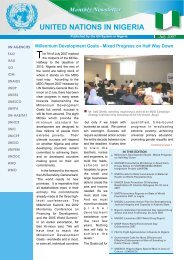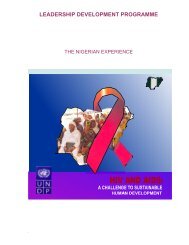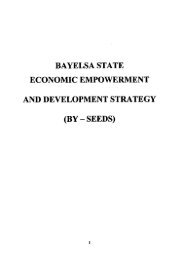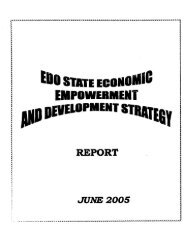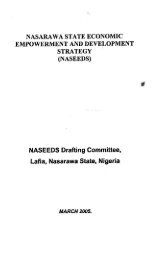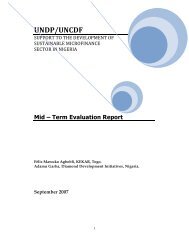Niger Delta Human Development Report - UNDP Nigeria - United ...
Niger Delta Human Development Report - UNDP Nigeria - United ...
Niger Delta Human Development Report - UNDP Nigeria - United ...
You also want an ePaper? Increase the reach of your titles
YUMPU automatically turns print PDFs into web optimized ePapers that Google loves.
Poverty has become<br />
a way of life due to<br />
economic stagnation,<br />
unemployment,<br />
poor quality of life<br />
due to shortages of<br />
essential goods and<br />
facilities, an unhealthy<br />
environment<br />
and government<br />
insensitivity.<br />
The critical issue in the <strong>Niger</strong> <strong>Delta</strong> is not<br />
only the increasing incidence of poverty,<br />
but also the intense feeling among the<br />
people of the region that they ought to do<br />
far better. This is based on the considerable<br />
level of resources in their midst, and<br />
the brazen display and celebration of illgotten<br />
wealth in <strong>Niger</strong>ia, most of which<br />
derives from crude oil wealth. This to a<br />
large extent explains why there is so much<br />
frustration and indignation in the region.<br />
The poverty rate based on self-assessment<br />
(or a perception index) is much higher than<br />
the data indicate—74.8 per cent in the<br />
South-South zone, for example. The perception<br />
of what poverty means is reflected<br />
by the responses of various participants<br />
in the focus group discussions conducted<br />
for this report (see box 2.1). The World<br />
Bank’s definition of poverty more or less<br />
confirms people’s views (see box 2.2).<br />
Even if poverty is measured as living on<br />
less than US $1 a day, the true levels of<br />
Box 2.1: Definition of Poverty by the People of the <strong>Niger</strong> <strong>Delta</strong><br />
Among the numerous descriptions of poverty offered by discussants<br />
in the focus groups conducted to prepare this report, the following<br />
descriptions are typical:<br />
(a). “The poor person is one who cannot pay school fees for<br />
his children; cannot meet any needs, including food; has<br />
no farm land and cannot farm well; cannot take part in<br />
age-grade activities (responsibilities that are specifically<br />
designated to some age groups in communities); cannot<br />
afford to send his children to school; wears tattered clothes;<br />
is very lean; and has no house to live in. In short, a poor<br />
person is one who has nothing. Consequently, he ‘has no<br />
voice’ in the community.”<br />
(b). “When you wake up hopeless as to where the next meal<br />
is coming from… when you cannot attend certain functions<br />
because you don’t have clothes …when your roof<br />
leaks and you cannot change it…when you cannot travel<br />
because the transport fares are high…and when the school<br />
fees and allied demands are too much to bear…. Then<br />
poverty is the cause.”<br />
Source: ERML fieldwork 2005.<br />
poverty in the region will still be underestimated.<br />
During the preparation of this<br />
report, focus groups maintained that poverty<br />
had become very prevalent in their<br />
localities and gave their opinions on the<br />
reasons behind this trend. One discussion<br />
made clear that poverty has become a way<br />
of life due to economic stagnation; agricultural<br />
underdevelopment from soil infertility;<br />
unemployment; poor quality of<br />
life due to shortages of essential goods,<br />
facilities and money; isolation and poor<br />
communication; government insensitivity;<br />
and an unhealthy environment spreading<br />
disease and malnutrition. Such conditions<br />
influence most members of the affected<br />
communities. It is not only income poverty<br />
that is the problem, therefore, but also<br />
the lack of access to social and physical<br />
infrastructure. When poverty is measured<br />
Box 2.2: Poverty as Defined by a<br />
Multilateral Organization<br />
Poverty is hunger. Poverty is being sick<br />
and not being able to see a doctor.<br />
Poverty is not having access to school<br />
and not knowing how to read. Poverty<br />
is not having a job, is fear for the<br />
future, living one day at a time. Poverty<br />
is losing a child to illness brought<br />
about by unclean water. Poverty is<br />
about powerlessness, lack of representation<br />
in decision making in the<br />
society and lack of freedom to express<br />
oneself.<br />
Poverty has many faces, changing<br />
from place to place and across time,<br />
and has been described in many ways.<br />
Most often, poverty is a situation<br />
people want to escape. So poverty is<br />
a call to action—for the poor and the<br />
wealthy alike—a call to change the<br />
world so that many more may have<br />
enough to eat, adequate shelter, access<br />
to education and health, protection<br />
from violence, and a voice in what<br />
happens in their communities.<br />
Source: The World Bank 2006, Poverty Net (http://<br />
web.worldbank.org/)<br />
2 The outcome of the poverty survey has been seriously debated, with the main thrust of the debate being that the evidence does not reflect<br />
the reality on the ground. Besides, given the enormous resources that have been generated from the region, there was no reason for it to<br />
experience even an iota of poverty.<br />
36 NIGER DELTA HUMAN DEVELOPMENT REPORT



